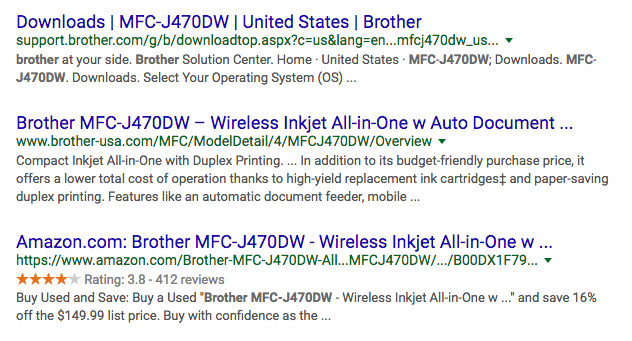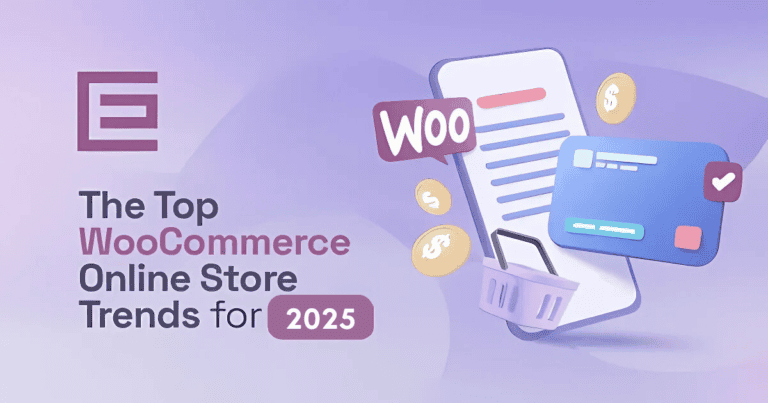View Case Study: 9 Times More Website Traffic for a Regional Trailer Sales Company
SEO Best Practices for Ecommerce Product Pages
On second thought, let’s take one small step backwards. Before we delve into how to convert your visitors in customers, let’s first discuss how we can get you some more visitors in the first place with proper on-site SEO.1. Write Descriptive Titles
It can be very tempting to just use the product name alone for your page titles, such as: Brother MFC-J470dw Unless someone is searching for the exact SKU, this page title does nothing to describe the product using words a normal person would search. A better title might be: Brother MFC-J4740dw Wireless All-in-One Color Laser Printer, Scanner, & Fax These descriptive words are all very likely to be used in a real search if you were looking for:- Wireless Printers
- Color Laser Printers
- All in One Printers
- Brother Wireless Color Printers
2. Write Original Product Descriptions
If you have a large number of products, writing unique descriptions for each one can be very time consuming. That means a lot of people will copy and paste all of their product descriptions directly from the manufacturer to save time. Guess what that means? A large percentage of your competitors will have the same exact content on their product and category pages. Google gives no love to duplicate content. If your store is the only one with well-written, unique product descriptions, you’ve got a leg up on the competition.3. Write Interesting Meta Descriptions
Not to be confused with your product descriptions, which will be visible on the product page, your meta descriptions will only be visible on search engine results pages. If your successful SEO efforts have you showing up on page one, that’s fantastic, but someone still needs to choose your site over the other dozen or so paid and organic listings on the page. Many manufacturer’s descriptions will include a lot of extra information on the page, like product dimensions and specs. If you copy that word for word or use no meta description at all, the result can end up looking like a string of numbers and characters. You want to strive for something a little more captivating in order to get that click. For some great ecommerce copy writing advice, check out Get More Ecommerce Sales Through Copywriting.4. Make Use of Schema.org Structured Data
Schema is a topic worthy of its own blog post, but let’s just say that with the proper mark up in your code, you can provide search engines with the ability to display rich snippets such as stock levels, pricing, reviews, and most importantly review stars. Which result draws your attention more? (Hint: it’s not the top two.)
Ecommerce Product Page Design Tips
On any webpage where a transaction happens, a set of psychological factors are at play. Whether that transaction involves the visitor giving you money for a product (ecommerce), or giving you their contact info for some kind of offer (lead generation), your visitors are all experiencing the same kind of emotions. For a thorough discussion on the psychology of landing pages, check out: What is a Landing Page? Your visitor comes to the page feeling hesitant. On a lead generation page, they are hesitant to part from their anonymity. On an ecommerce page, they are hesitant to part with their money. Here are some things to include on your ecommerce product pages to help your visitors conquer their fears and hesitate no more:5. Use High Quality Photos
The one thing you don’t get shopping online is the ability to touch and feel the item you are buying. This is a huge hurdle. Imagine if you went to the grocery store to buy bananas, and all you could see in the produce isle was a picture of bananas before you had to commit to purchasing them. Make sure you have big, sharp, well-lit product images from multiple angles, so you can come as close to an in-person experience as possible.6. Answer Questions Before They Arise
If there is one thing that causes buyer hesitation, it’s uncertainty. How much is shipping? What size should I get? When will it arrive? What is your return policy? Prominently featuring the answers to these questions will do wonders to your conversion rate. Be specific. A sentence like the one below gives your visitor confidence: Place your order by 6pm today, and get guaranteed delivery by Wednesday, July 26th. Return your item for any reason within 30 days, no questions asked. This doesn’t leave anything to the imagination. Also, beyond shipping and returns, your particular product might have a long list of common questions. Put those FAQ’s right where no one can miss them. (They can be in an expandable drop down, so they don’t take up the whole page). Never hide this info until the final part of the checkout process. Nobody wants to fill out a bunch of form fields only to get hit with an extra shipping fee on the next step. Show the visitor everything they need to know about the process from the beginning.7. Add a Wish List
A wish list is a nifty feature that allows people to save the products they are interested in, so they can view or purchase later. In addition to giving your visitors a convenient function to use and a reason to return to your site, the wish lists provides you, the retailer, with additional opportunities to market to your customers. First of all, they must enter an email address to create an account. With an email address, now you can send them periodic reminders about the items in their wish list. You can offer discounts, notify them of upcoming events or sales, or even let them send their wish list to a friend or relative. This can be very handy around the holidays.8. Add Customer Reviews
At this point, it probably goes without saying that reviews are extremely important, but this list of tips would be incomplete without at least mentioning them. Get as many reviews as you can. It matters. That pretty much covers it.9. Cross Selling / Upselling
This is the internet’s version of “Do you want fries with that?” Done correctly, upselling and cross selling actually makes your customers’ experience easier. There’s a really good chance that someone who just bought some Gore-Tex hiking boots would also be interested in some specialty socks. Placing related product suggestions conveniently in sight on the product page prevents the visitor from having to start over and perform a whole new search. For the best results, make sure your suggested products are highly relevant. This usually requires some thought. Most set-it-and-forget-it plugins will default to suggesting other products from the same category. Someone who just bought some sneakers doesn’t need another pair of sneakers. That doesn’t really make sense. Think about what people would really want.10. Add Recently Viewed Items
Okay, so maybe we got some of these ideas from Amazon, but there’s probably a reason they sell a bazillion dollars a per year. Recently viewed items are just another layer of added convenience for your online shopper. Stores with a lot of products can be overwhelming to navigate. It’s easy to find something specific, continue browsing, then forget what you found earlier. Recently viewed products provide an easy way to see your recent history at a glance11. Bonus Tip: Take Credit Where it is Due
Many online stores offer free shipping, free returns, free support, and other complimentary services. In reality, none of these things are actually free. There is no such thing as free shipping, and customer support reps have salaries. You, the online store owner, are eating the costs of these services. Instead of offering “free” shipping and returns, try saying that you’ll cover the cost of shipping and returns. Instead of offering free support, talk about how you’ll gladly take the time to help them. You want your customers to understand the amount of value you are providing to them, and calling these things free is selling yourself short. With these basic product page SEO and design tips, you can attract more visitors to your site and turn more of them into paying customers.Tags: Digital Marketing • Ecommerce • Search Engine Optimization




